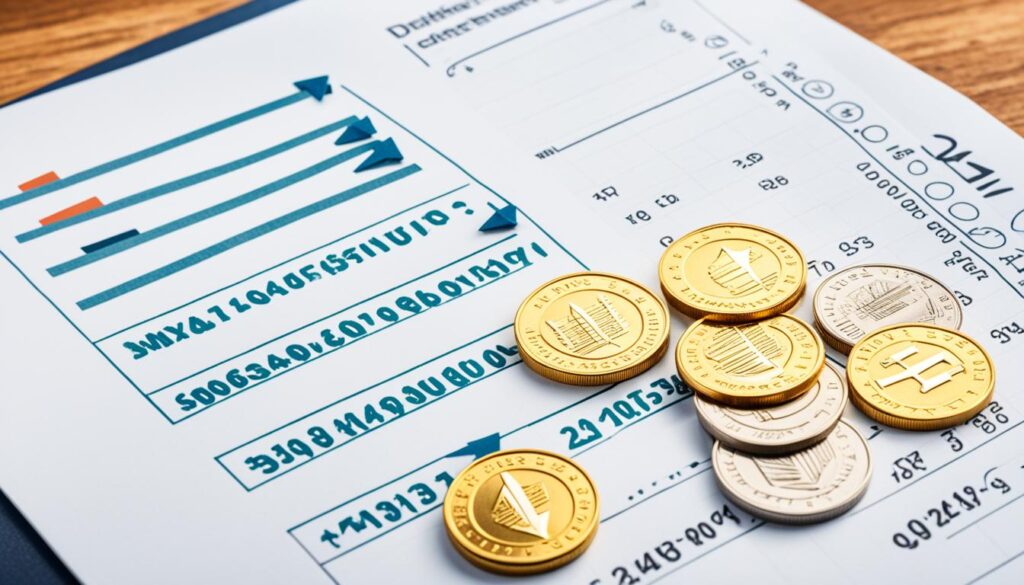When it comes to planning for your retirement income, it’s crucial to consider strategies that can maximize non-taxable sources of income. By utilizing tax-efficient planning techniques, you can ensure a financially secure future while minimizing your tax liabilities. In this article, we will explore key strategies that can help you maximize your non-taxable retirement income. One effective approach is to maximize pension contribution strategies, which can significantly enhance your retirement income while reducing your taxable income in the present. Additionally, leveraging health savings accounts (HSAs) and municipal bonds can provide further non-taxable income streams. By carefully evaluating your options and implementing these strategies, you can build a robust retirement plan that prioritizes tax efficiency and long-term financial stability.
Key Takeaways:
- Living in a tax-friendly state can provide significant tax advantages in retirement.
- Reassessing your investments to include tax-efficient options like municipal bonds and qualified dividends can help increase your tax-free income.
- Strategies such as avoiding or postponing required minimum distributions (RMDs) and utilizing deferred annuities can keep your retirement income tax-free.
- Being strategic about your Social Security benefits can help minimize taxes and maximize your non-taxable income.
Live in a Tax-Friendly State
One effective strategy for maximizing non-taxable retirement income is to live in a tax-friendly state. States like Alaska, Florida, Nevada, South Dakota, Tennessee, Texas, Washington, and Wyoming have no income taxes. Additionally, some states offer special breaks for retirement income, such as no tax on Social Security benefits or tax exemptions for income from IRAs and retirement plans.
By choosing to reside in a tax-friendly state, retirees can enjoy significant tax advantages in retirement. Minimizing tax liabilities in retirement can have a substantial impact on one’s overall financial well-being and retirement lifestyle. Moving to a tax-friendly state can help retirees keep more of their hard-earned money, allowing them to stretch their retirement savings further and enjoy a higher quality of life.
One of the key tax benefits of living in a tax-friendly state is the absence of state income taxes. By eliminating income taxes, retirees can keep more money in their pockets, minimizing tax liabilities in retirement and maximizing their post-tax retirement income.
Tax-Friendly States for Retirement
| State | Income Tax | Social Security Benefit Tax | Retirement Income Tax Exemptions |
|---|---|---|---|
| Alaska | No state income tax | No tax on Social Security benefits | No income tax on retirement income |
| Florida | No state income tax | No tax on Social Security benefits | No income tax on retirement income |
| Nevada | No state income tax | No tax on Social Security benefits | No income tax on retirement income |
| South Dakota | No state income tax | No tax on Social Security benefits | No income tax on retirement income |
| Tennessee | No state income tax (except on interest and dividends) | No tax on Social Security benefits | No income tax on retirement income |
| Texas | No state income tax | No tax on Social Security benefits | No income tax on retirement income |
| Washington | No state income tax | No tax on Social Security benefits | No income tax on retirement income |
| Wyoming | No state income tax | No tax on Social Security benefits | No income tax on retirement income |
Living in one of these tax-friendly states can provide retirees with substantial tax advantages in retirement. By reducing or eliminating income taxes, retirees can minimize their tax liabilities in retirement and have more disposable income to use for living expenses, travel, leisure activities, and other important aspects of their retirement lifestyle.
Reassess Your Investments
Another way to maximize non-taxable retirement income is to reassess your investments. By strategically choosing tax-efficient investment strategies, you can minimize the impact of taxes on your retirement income. Consider the following options:
Tax-Efficient Municipal Bonds
One tax-free investment strategy to explore is investing in municipal bonds. Municipal bonds are debt securities issued by state and local governments to fund public projects such as schools, highways, and hospitals. They offer tax-exempt interest income, making them an attractive option for tax-efficient investments. Unlike other types of bond income, the interest earned from municipal bonds is usually not subject to federal income tax. Additionally, if you invest in bonds issued by your home state, the interest may also be exempt from state and local taxes.
Qualified Dividend Stocks
Dividend stocks are another tax-efficient investment option to consider. Qualified dividends are distributions from stocks of publicly-traded U.S. corporations and certain foreign corporations, and they are taxed at more favorable rates than ordinary income. The tax rates on qualified dividends range from 0% to 20%, depending on your income level. By including dividend stocks in your investment portfolio, you can potentially earn tax-free income and further boost your retirement savings.
Capital Losses and Gains Offset
To reduce your tax liability, consider utilizing capital losses to offset capital gains. When you sell an investment at a loss, you can use that loss to offset any capital gains you have realized. This strategy can help reduce the taxes owed on your investment gains and maximize your after-tax returns. However, it’s important to consult with a tax professional to understand the specific rules and limitations regarding capital losses and gains offset.

Reassessing your investments and employing tax-efficient strategies can significantly impact your retirement income. By incorporating municipal bonds, dividend stocks, and capital gains offset strategies into your investment portfolio, you can increase your non-taxable income and enhance your overall retirement planning.
Remember, investment decisions should always consider your individual financial circumstances and goals. Consulting with a financial advisor or tax professional is recommended to ensure a suitable investment strategy based on your unique needs.
Avoid or Postpone RMDs
Required minimum distributions (RMDs) from retirement accounts can be subject to taxes. However, there are strategies to avoid or postpone RMDs and keep your retirement income tax-free.
One effective strategy is to transfer funds from your traditional IRA directly to an IRS-approved charity. This allows you to avoid tax on the distribution if you are at least 73 years old. By making a qualified charitable distribution (QCD), you can satisfy your RMD and support a cause you care about at the same time.

Another option to consider is investing in deferred annuities. With deferred annuities, you can postpone RMDs and ensure a steady stream of tax-exempt retirement income. This can be especially beneficial if you have other sources of income in retirement and want to delay tapping into your retirement accounts.
Deferred annuities work by allowing you to accumulate funds on a tax-deferred basis. You contribute to the annuity during your working years and then start receiving regular payments once you reach a certain age. By postponing RMDs, you can potentially reduce your taxable income and keep more of your retirement savings growing tax-free.
It’s important to note that deferred annuities may have fees and other expenses, so it’s essential to carefully evaluate the terms and conditions before investing.
Benefits of Avoiding or Postponing RMDs:
- Retain control over your retirement savings
- Reduce your taxable income in retirement
- Potentially grow your retirement savings on a tax-deferred basis
- Create a tax-efficient retirement income strategy
Considerations for Investing in Deferred Annuities:
- Evaluate the terms and conditions, including fees and expenses
- Understand the surrender charges and withdrawal options
- Consult with a financial advisor to determine if deferred annuities align with your retirement goals
By avoiding or postponing RMDs and exploring options like qualified charitable distributions and deferred annuities, you can optimize your retirement income and enjoy tax-free withdrawals from your retirement accounts.
How Can Non-Taxable Retirement Income Sources Contribute to Maximizing Steady Retirement Income Streams?
Non-taxable retirement income sources play a crucial role in maximizing retirement income streams. By utilizing non-taxable sources such as Roth IRAs and municipal bonds, retirees can ensure a steady stream of income without the burden of excessive taxes, thereby maximizing retirement income streams for a secure financial future.
Be Strategic About Social Security Benefits
Social Security benefits can be subject to taxes depending on your income. To minimize taxes and maximize non-taxable income, it’s crucial to be strategic when it comes to your Social Security benefits. One effective strategy is to consider delaying the receipt of benefits until you reach the age of 70. By doing so, you can earn additional credits and boost your monthly benefits without incurring taxes.
Another way to control the taxable portion of your Social Security benefits is by managing your provisional income. Contributing to deductible Individual Retirement Accounts (IRAs) can help reduce your taxable income and increase your non-taxable benefits. Additionally, limiting securities sales can also be a smart move to keep your provisional income lower.
By carefully planning and implementing these strategies, you can ensure that a significant portion of your Social Security benefits remains tax-free. This can have a positive impact on your overall retirement income, giving you more financial freedom and peace of mind.
FAQ
What are some strategies for maximizing non-taxable retirement income?
Strategies for maximizing non-taxable retirement income include living in a tax-friendly state, reassessing your investments for tax-efficiency, avoiding or postponing required minimum distributions (RMDs), and being strategic about Social Security benefits.
How can I live in a tax-friendly state to maximize non-taxable retirement income?
Living in a tax-friendly state, such as Alaska, Florida, Nevada, South Dakota, Tennessee, Texas, Washington, or Wyoming, can help maximize your non-taxable retirement income. These states either have no income taxes or offer special breaks for retirement income.
How can I reassess my investments to maximize non-taxable retirement income?
Reassessing your investments can help maximize non-taxable retirement income. Consider shifting your investments to tax-efficient options like municipal bonds, which offer tax-exempt interest income. Qualified dividends from publicly-traded U.S. corporations and certain foreign corporations are also taxed at more favorable rates.
How can I avoid or postpone required minimum distributions (RMDs) to keep my retirement income tax-free?
To avoid or postpone RMDs and keep your retirement income tax-free, you can transfer funds from your traditional IRA directly to an IRS-approved charity if you are at least 73 years old. Additionally, investing in deferred annuities can help delay RMDs and ensure a steady stream of tax-exempt retirement income.
How can I be strategic about my Social Security benefits to minimize taxes and maximize non-taxable income?
To be strategic about Social Security benefits, consider delaying the receipt of benefits until age 70 to earn additional credits and boost your monthly benefits without incurring taxes. Controlling your provisional income through strategies like contributing to deductible IRAs and limiting securities sales can also help reduce the taxable portion of your Social Security benefits.

